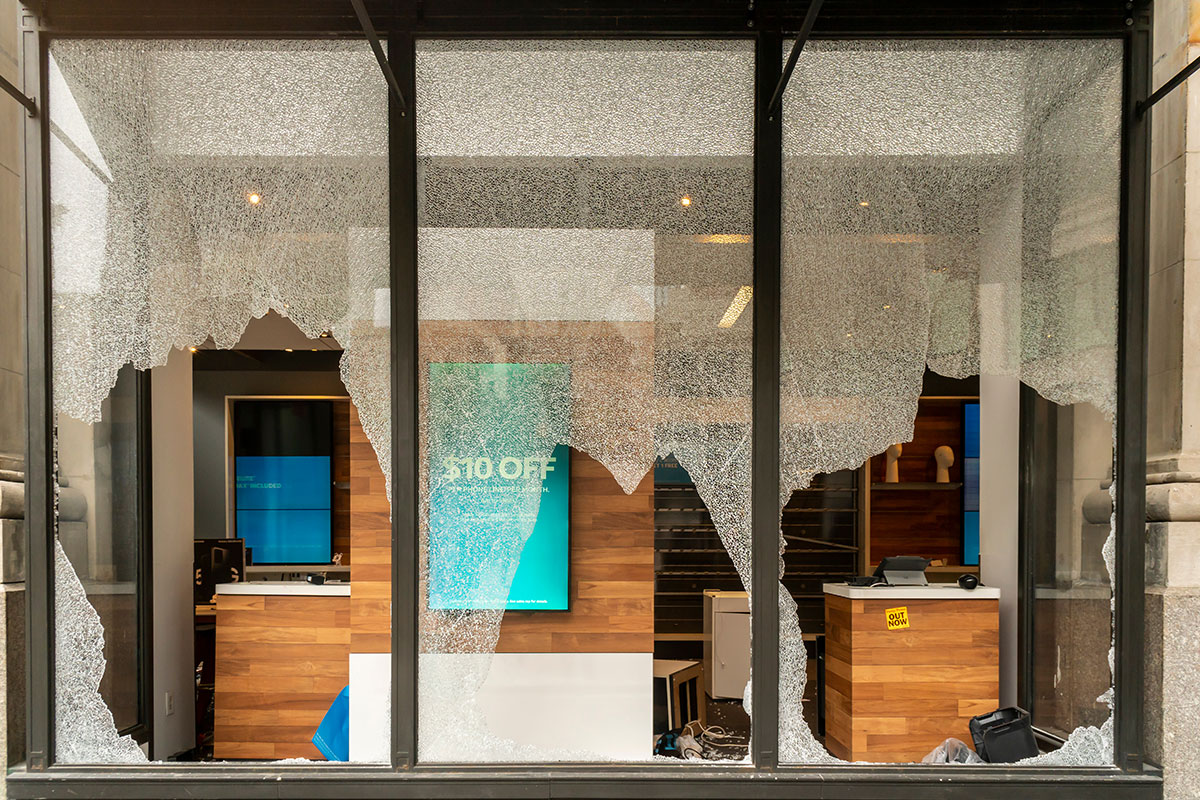Digital Transformation in the Retail Industry
The retail industry has undergone a significant transformation over the last decade, as prominent retail brands have invested heavily in digital transformation, underpinned by advances in cloud computing and the widespread adoption of e-commerce. The pandemic in 2020 and the subsequent reopening of the economy accelerated changes driven by changing customer expectations and non-traditional demands of Millennials and Gen Z customers.
In 2026, retailers face unprecedented margin pressure. Labor shortages remain 40% above targets, return costs consume up to 53% of delivery expenses, and Forrester predicts three major US specialty retailer bankruptcies. Technology is no longer optional; it is essential for survival.
Retailers have no option but to continue investing in new technologies and stay ahead of the curve. We look at six emerging yet important retail technology trends that retailers should evaluate in 2026, prioritized by business impact: margin defense first, operational efficiency second, and customer experience third.
1. Unified Data Platforms and Agentic AI
What are Unified Data Platforms and Agentic AI?
Unified data platforms serve as the foundation that enables agentic AI systems to operate reliably in retail. These platforms consolidate fragmented data sources into a single real-time intelligence layer. They integrate POS transactions, inventory levels, customer profiles, supply chain signals, and workforce data through APIs. Agentic AI systems use this clean data foundation to observe business conditions, reason through options, plan responses, and execute decisions autonomously or with human review.
Walmart’s agentic AI merchant tools automate time-intensive entry and analysis tasks. The Trend-to-Product system shortens fashion production timelines by 18 weeks. Customer Support Assistant agents route inquiries, resolve issues, and act independently to free associates for complex work.
What are the Key Drivers for Unified Data + Agentic AI?
- Gartner forecasts that 40 percent of enterprise applications will integrate AI agents by 2026, but 30 percent of generative AI projects will be abandoned after proof-of-concept by the end of 2025 due to poor data quality.
- Retail labor challenges persist. Deloitte’s 2025 US Retail Industry Outlook reports that two-thirds of retail executives plan moderate-to-major investments toward workforce hiring and retention due to high turnover rates among frontline workers.
- Generative AI economics are now viable. AI training costs are projected to decline 75% annually till 2030, making agentic systems economically feasible when paired with unified data platforms.
Technology Implications of Implementing Unified Data + Agentic AI
Retail CIOs face these critical realities:
- Data governance must precede AI deployment. Automated data quality tools and master data management prevent generative AI from amplifying inventory inaccuracies across autonomous systems.
- Real-time streaming replaces batch ETL processes. Agentic AI requires sub-second data latency for live POS, inventory, and customer signal processing.
- Composable architecture proves essential. MACH principles (Microservices, API-first, Headless, Composable) connect siloed ERP, POS, and CRM systems without rip-and-replace disruption.
- Cross-functional governance becomes mandatory. Agentic AI cannot be built with siloed planning teams.
- Demand, pricing, and inventory decisions require unified ownership across functions.
- Compute demands increase significantly. Generative AI inference workloads require 20 to 30 percent cloud budget escalation. Robust backup and disaster recovery systems become non-negotiable for mission-critical operations to recover from possible AI hallucinations or mistakes.
2. Contactless Stores
What are Contactless Stores?
Contactless stores leverage advanced technologies to deliver a seamless, fast, and safe shopping experience by reducing physical interactions at key touchpoints. These stores employ solutions like e-commerce, buy online and pick up in-store (BOPIS), curbside pickups, self-checkout kiosks, NFC-based payments, mobile wallets, and AI-powered cashier-less checkout systems, such as Amazon’s Just Walk Out.
In addition, retailers are streamlining shopping with AI-powered smart carts for seamless checkout, Augmented Reality apps for product visualization and in-store navigation, and biometric payments for speed and security. Walmart is deploying electronic shelf labels across 2,300 stores by 2026, enabling AI-driven dynamic pricing without manual intervention.
What are the key drivers for contactless stores?
While contactless technologies have been in existence for years, their adoption skyrocketed during the COVID-19 pandemic as retailers prioritized safety and convenience. The momentum has continued post-pandemic, driven by shifting consumer expectations for faster and more convenient shopping experiences. US retailers are expected to hire about 40% fewer seasonal workers in the 2025 holiday season when compared to 2024, and technologies that enable contactless stores will start filling in the labor gap.
Recent data points to the continued growth and adoption of contactless payment methods and BOPIS services in the United States:
- The U.S. contactless payment market is expected to reach approximately $164 billion by 2030, with a compound annual growth rate (CAGR) of 19.1% from 2022 to 2030.
- By 2027, digital wallets will account for more than $25T or 49% of global transaction value across e-commerce and POS.
- The U.S. buy-online-pick-up-in-store (BOPIS) market is projected to grow at a compound annual growth rate (CAGR) of 16.45% between 2024 and 2032, increasing from $111.84 billion in 2023 to $440.39 billion by 2032.
Technology implications of implementing contactless stores for retailers
- Depending on the extent and scope of contactless store implementation, retailers may have to review bandwidth availability, LAN/WAN/Wi-Fi capabilities, network security, and security camera coverage at the store. 5G and edge computing technologies are required for real-time AI processing, with 30% of retailers achieving IT cost reductions through distributed edge networks projected by 2028.
- Cashierless stores require a bevy of technologies to work together. Computer vision, artificial intelligence-enabled cameras, RFID strips, infrared lead sensors, microphones, and mobile apps work together to offer the convenience of walking in and leaving the store without checking out.
- POS system may need an upgrade to offer additional payment options and integrate POS with sensors. In some implementations (such as Amazon’s Just Walk Out), the concept of POS, as we know it today, may not even exist as a virtual shopping cart is updated in real-time as the customer adds items into the basket.
- Self-checkout, digital wallets, and BOPIS require a recalibrated approach to loss prevention to address theft and online fraud. Visa reports that BOPIS transactions lack shipping address data and secure payment capture, increasing fraud risk. AI-powered video analytics combined with unified data platforms can achieve 85 to 95% accuracy in anomaly detection.
- Customer privacy concerns can become an issue when every customer is uniquely identified and tracked throughout the store. CCPA compliance is mandatory, and agentic AI systems require explicit consent frameworks and data minimization protocols to protect customer privacy.
3. Artificial Intelligence (AI) Enabled Security Cameras
What Are AI-Enabled Cameras?
AI cameras use artificial intelligence to make sense of the videos being recorded. They can be programmed to detect certain types of objects or human activity, movement, removal of objects, read license plates or even recognize faces.
AI-enabled security cameras can boost the effectiveness of remote video monitoring or surveillance.
Security operators monitoring the feeds can get real-time alerts when the camera detects any of the anomalies the AI program is trained for thereby allowing security teams to act before a crime is committed.
AI-enabled security camera systems offer a searchable footage library making it easy to quickly find footage of relevance and doing away with the need sift through hours of recorded footage during investigations.
Advanced AI-enabled security cameras have deep learning capability and can become progressively good at recognizing patterns and detecting anomalies in the video being recorded.
Interface’s autonomous virtual perimeter guard includes an intelligent IP camera that uses artificial intelligence to detect people or vehicles and play customizable pre-recorded warning messages to prevent loitering, vandalism, or break-ins after business hours.
What Are the Key Drivers for AI-Enabled Cameras?
A recent market study concluded that the global AI camera market was worth $7.4 billion in 2020 and is further projected to reach $33.3 billion by the year 2027, growing at a CAGR of 24.0%.
A combination of factors is driving up demand and use for AI-enabled cameras.
- A study conducted by PwC showed that US companies accelerated investments in AI technologies in the wake of the COVID crisis. According to PwC, “AI leaders are building a virtuous cycle, sometimes called a flywheel: AI leads to better products, increased productivity, and superior customer experiences.”
- AI technology has matured in the last few years to a point where anyone can access AI frameworks and pre-built solution components on popular public clouds like AWS, Azure, and Google Cloud Platform. The ROI of implementing AI-enabled cameras is now compelling resulting in increased adoption.
- The U.S Bureau of Labor Statistics estimates that the labor market for investigation and security services is expected to grow by 6.5%. However, security monitoring service providers are finding it challenging to hire and retain security professionals. AI-enabled cameras can address this issue by delivering increased productivity and improving the quality of monitoring jobs by eliminating monotonous tasks.
- 5G rollout is turning out to be a catalyst for the growth of sensors with edge computing capabilities. Sophisticated cameras with AI capabilities on 5G networks can push more high-quality video streams faster for further processing and analysis resulting in superior monitoring outcomes.
Technology Implications of Implementing AI-Enabled Cameras for Retailers
Enterprises looking to upgrade analog cameras can take one of the below approaches to executing the transition.
- Replace analog cameras with IP cameras (with AI capabilities) along with the cabling. This is a “rip and replace approach” and the investment needed will depend on the number of sites and number of cameras that need to be replaced.
- Replace the cameras without replacing the coaxial cables is an option worth considering if the cable runs are complex. In this case, IP to coaxial cabling adapters can push the videos into a video management system.
- Start with proven AI security solutions before advancing to solving complex problems that might require additional sensors and sensor fusion. AI use cases such as intruder detection during off-business hours, and loitering in the perimeter area is proven and can deliver ROI faster.
- Upgrade your surveillance system in stages to manage costs and minimize operational disruptions. A phased approach allows for gradual integration of new technologies while maintaining security coverage.
4. Retail Demand Planning
What Is Retail Demand Planning?
Retail demand planning is the process of forecasting demand for products across all channels (in-store, e-commerce, BOPIS, ship from store) taking into consideration historical demand patterns, business decisions and external factors such as competitor offers.
Demand planning helps retailers navigate complex challenges across all aspects of retail operations.
- Streamlined store and distribution center replenishment
- Better workforce planning and optimization
- Optimized product promotions and discounts
- Optimized assortment planning
- Better space planning and optimization
- Improved budgeting and cash flow management
What Are the Key Drivers for Retail Demand Planning?
The pandemic forced retail chains to go through years of growth in just a few months! e-Commerce and new fulfillment channels are no longer seen as a differentiator as customers expect to find the products they want no matter where and how they shop.
The only way retailers can meet these expectations is by upgrading to a data-driven, real-time demand planning approach. Retailers are already upgrading their demand planning capabilities to process more data or variables in the planning process at scale while relying on human planners for qualitative input and exception management.
In fact, Gartner recommends leveraging AI-driven demand planning tools that integrate real-time market data, customer behavior insights, and supply chain variables to improve accuracy and agility in forecasting.
Here are some of the key drivers for demand planning innovation in the retail industry:
- Trust depends on retailers’ ability to deliver value and excellence in managing the inventory. Having the right product and getting it to their hands in their preferred channel is a great strategy to rebuild trust. According to Walter Robb, Former Co-CEO of Whole Foods, “Some customers say they want to be served in certain ways, such as grocery customers saying they want to pick up items in-store or have certain things delivered. It’s up to brands to develop the capabilities to serve customers how and when they want to be served. Brands earn trust when they listen to customers and are willing to meet their needs.”
- Fulfillment complexity is increasing with new channels graduating from a fad to becoming mainstream. In addition to e-Commerce and BOPIS, grocery retailers will soon have one more fulfillment center, i.e., the customer’s home. According to Gartner, by 2025, ‘at-home replenishment as a service’ will surge to 5% of multi-channel grocery retailers’ total revenues. Advancements in IoT and smart home devices are accelerating this trend, enabling seamless auto-replenishment services for consumers. Amazon and Walmart are already piloting smart refrigerators and coolers that can be automatically tracked and restocked.
- In 2025, personalization in demand planning has become essential, with consumers expecting tailored product recommendations and precise inventory availability based on their preferences and purchase history. To address this, retailers are transforming physical stores into fulfillment centers, enabling faster delivery and efficient order processing while offering personalized products.
- Customer consumption patterns are also evolving, and the pandemic created distinct consumption patterns that impacted demand planning for retailers. McKinsey identified four distinct consumption patterns during and after the COVID-19 pandemic:
- Pantry load and consume (consumption expands). Example: Cleaning supplies, vitamins, and supplements. Consumption increased during the pandemic and continues to hold ground even after the pandemic.
- Pantry load and preserve (consumption does not change). Example: Pet food and toilet paper. Consumption did not actually increase during the crisis, resulting in post-crisis volume declines.
- Now at home (consumption shifts). Work-from-home and shelter-in-place policies force consumers to shift on-the-go occasions for products such as coffee and alcohol from in-person food-service outlets to online retailers.
- Not now (consumption declines). Declining consumer confidence and a focus on essential categories lead to a decrease in purchasing certain goods during the crisis—for example, beauty, food, and beverages for immediate use. Purchasing levels for these categories are returning to normal after the crisis.
- While most retailers have a lot of valuable data, many of them still lag behind in their ability to extract meaningful business insights from the data on time. Considering the retail market is going through a dynamic growth phase driven by changing customer preferences, there is a need for innovative approaches to demand planning. According to Relex, a retail demand planning platform, retailers can bridge the data utilization gap by combining artificial intelligence and machine learning with statistical modeling and optimization, simulation, classification, as well as rules and heuristics. Additionally, cloud-native demand planning solutions enable scalable and flexible forecasting models that can adapt to supply chain disruptions.
- Better demand planning requires an ability to crunch data at scale. Advances in in-memory computing, hybrid analytical/transactional data processing, and cloud computing infrastructure that can scale processing on-demand have allowed demand planning vendors to deliver innovative products for realistic scenario simulations.
- Reducing food waste is becoming a key challenge for grocery retailers. Increasingly socially conscious customers are looking to spend their money with retailers aligned with similar values. California’s SB1383 legislation mandates grocery retailers to follow specific guidelines to dispose of unsold produce. The goal of this legislation is to minimize produce being dumped in landfills (which contributes to pollution) and instead divert the produce to non-profit organizations. Retailers failing to meet the norms are liable to pay penalties.
Technology Implications of Implementing Retail Demand Planning
The following are some of the factors CIOs and IT organizations should consider when choosing to implement sophisticated demand planning applications.
- Among the several critical features required in a retail demand planning platform, Forrester has identified segmenting and clustering, demand management, inventory planning and operational effectiveness, and agile merchandising as core features to be evaluated when choosing a retail demand planning application.
- Any plans for a unified demand planning software implementation should take into consideration organizational bottlenecks. If the retailer has planning teams working in silos with each team responsible for specific channels, implementing a demand planning solution that requires closer collaboration and joint decision-making on a daily basis will cause friction and turf wars. Implementing a demand planning software will involve some level of organizational restructuring to leverage all the benefits associated with a collaborative approach to demand forecasting cutting across channels.
- Considering the intensive compute requirements for running machine learning and AI algorithms to create demand forecasts, retailers need to budget for cloud computing cost escalations along with fund allocations for backup and disaster recovery.
- Any retail demand planning implementation should take into consideration robust data-sharing protocols with suppliers. The applications should have the ability to automatically share demand data at the right level of granularity that the suppliers can then use to plan their deliveries and manufacturing. A feedback loop may also be needed from the supplier end to plan for any variation between demand and supply.
- Data quality and data governance are critical to the successful implementation of any demand planning software. Retail chains that have grown through acquisitions and saddled with diverse systems with inefficient data collection or data centralization processes can find it challenging to implement a unified demand planning solution. A focused approach to solving data collection and data quality issues should be in every retail CIO’s roadmap.
The pandemic forced retail chains to go through years of growth in just a few months! e-Commerce and new fulfillment channels are no longer seen as a differentiator as customers expect to find the products they want no matter where and how they shop.
5. Retail Media Networks
What are Retail Media Networks
Retail media networks help retailers sell advertising on their own properties using their shopper data. Retailers show ads from brands on their websites, mobile apps, email, and in-store digital screens, and then connect those ads to actual sales in their stores or online.
Top examples include Amazon Ads (largest with 75% US market share), Walmart Connect ($4.4B revenue), and Target Roundel ($649M revenue).

When a shopper browses a retailer’s site or scans a loyalty card in-store, the retailer captures what they view and what they purchase. A retail media network utilizes this information (first-party data) to display relevant ads, such as sponsored products in search results or personalized offers within the app, and to report back to brands the number of sales generated by those ads.
What are the Key Drivers for Retail Media Networks?
Two primary factors are driving adoption:
- BCG expects the retail media network to grow to a $100 billion market by 2026 and account for 25% of total digital media spending. The reason for this growth is that brands get access to first-party data from retailers via loyalty programs, purchase history, and in-store behavior, allowing them access to buyers with a greater intent to engage with the brands.
- Retailers that have already launched media networks have gained immensely. Walmart made $4 billion in ad revenues in 2024, and Target made $649 million via its ad network. Retail media generates high-margin revenue without physical inventory investment, and hence, retailers, big and small, are jumping on the bandwagon to monetize their customer data.
Technology implications for retailers
- Retailers must decide whether to build their own ad stack, white-label a platform, or use a managed service, with each path trading off control, speed, and cost. Large players like Walmart and Target skew to in-house builds, while mid-market retailers increasingly launch on white-label or third-party platforms to get to revenue faster.
- Adtech must integrate cleanly with e-commerce, mobile apps, POS, loyalty, and inventory systems to enable accurate targeting and execution. Poor integration shows up as wrong prices, out-of-stock items being promoted, and inconsistent audience activation across channels.
- Retailers need a unified identity layer that links web accounts, app IDs, loyalty profiles, and in-store transactions to a single shopper view. Without this, networks cannot offer the audience precision and closed-loop attribution that brands expect from retail media.
- Real-time or near-real-time data pipelines are required to feed bidding, frequency capping, and personalization decisions. Batch-based data flows quickly become a bottleneck, causing lag in campaign optimization and stale performance reporting.
- Reporting infrastructure must support advertiser-facing dashboards with SKU-level, store-level, and audience-level views updated frequently. Underpowered analytics stacks lead to slow, manual reporting and erode advertiser confidence in the network.
- Governance and privacy controls must define what first-party data can be used, how it is shared with partners, and how consent is managed. Weak governance exposes retailers to regulatory risk and can scare off brands that demand clear, compliant data practices.
Retail Technology Trends That Failed to Take Off
Retailers chased several high-profile technologies that generated massive hype but never scaled due to cost, complexity, consumer resistance, and poor ROI.
- Contactless/Cashierless Stores: While this remains in our list of trends to watch, Amazon Just Walk Out, and similar systems promised checkout-free shopping, but high camera/sensor costs, shrink risks, and privacy concerns limited adoption to pilots. We hope 2026 will see an uptick in adoption.
- Beacon/Indoor Location Tech: Proximity marketing beacons died from shopper opt-outs, battery drain, and negligible sales lift despite early Apple-iBeacon buzz.
- Smart Mirrors/AR/VR In-Store: Fashion try-on mirrors and virtual store tours saw pilots shelved after low usage rates and exorbitant maintenance costs eroded ROI.



